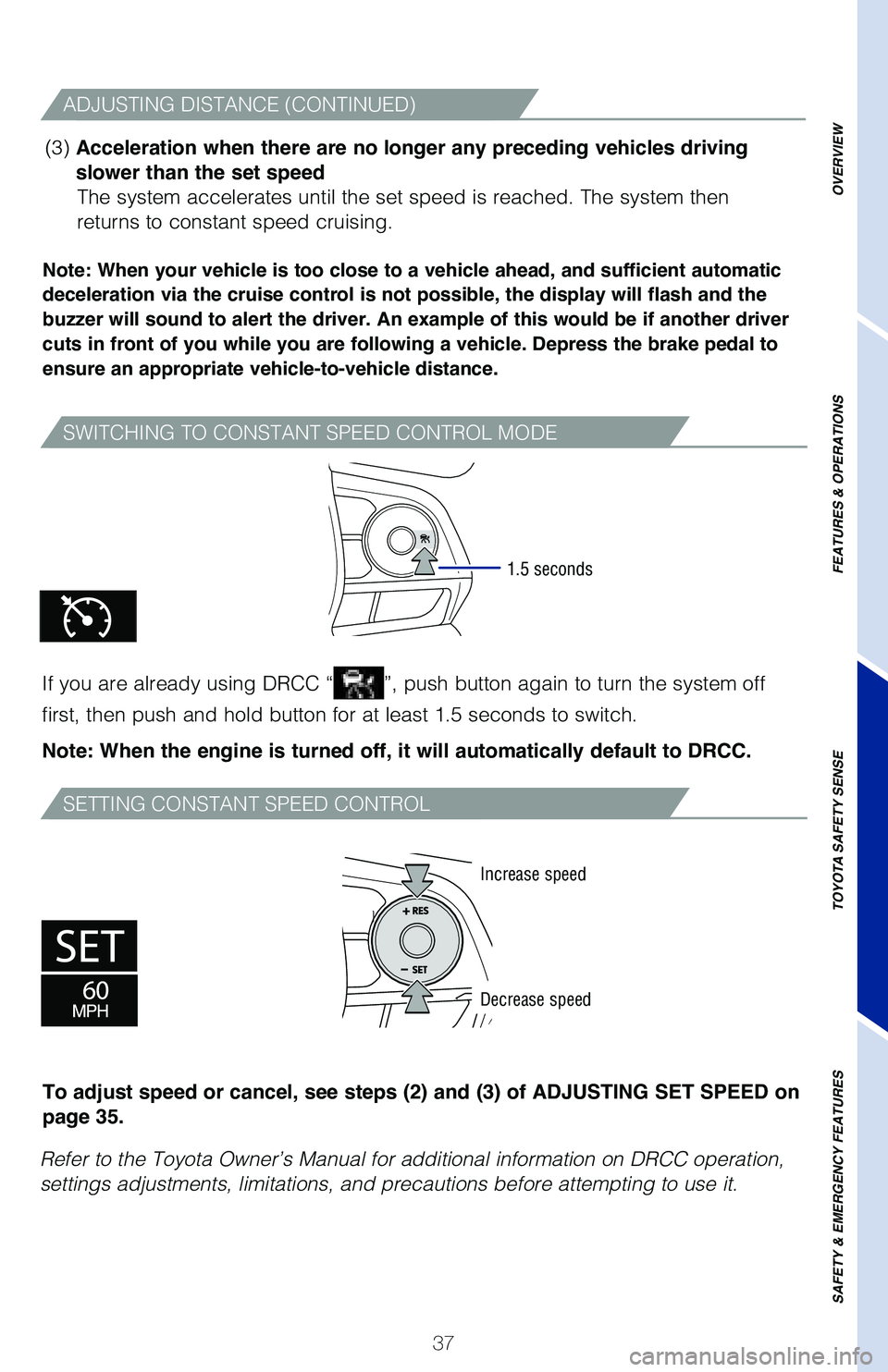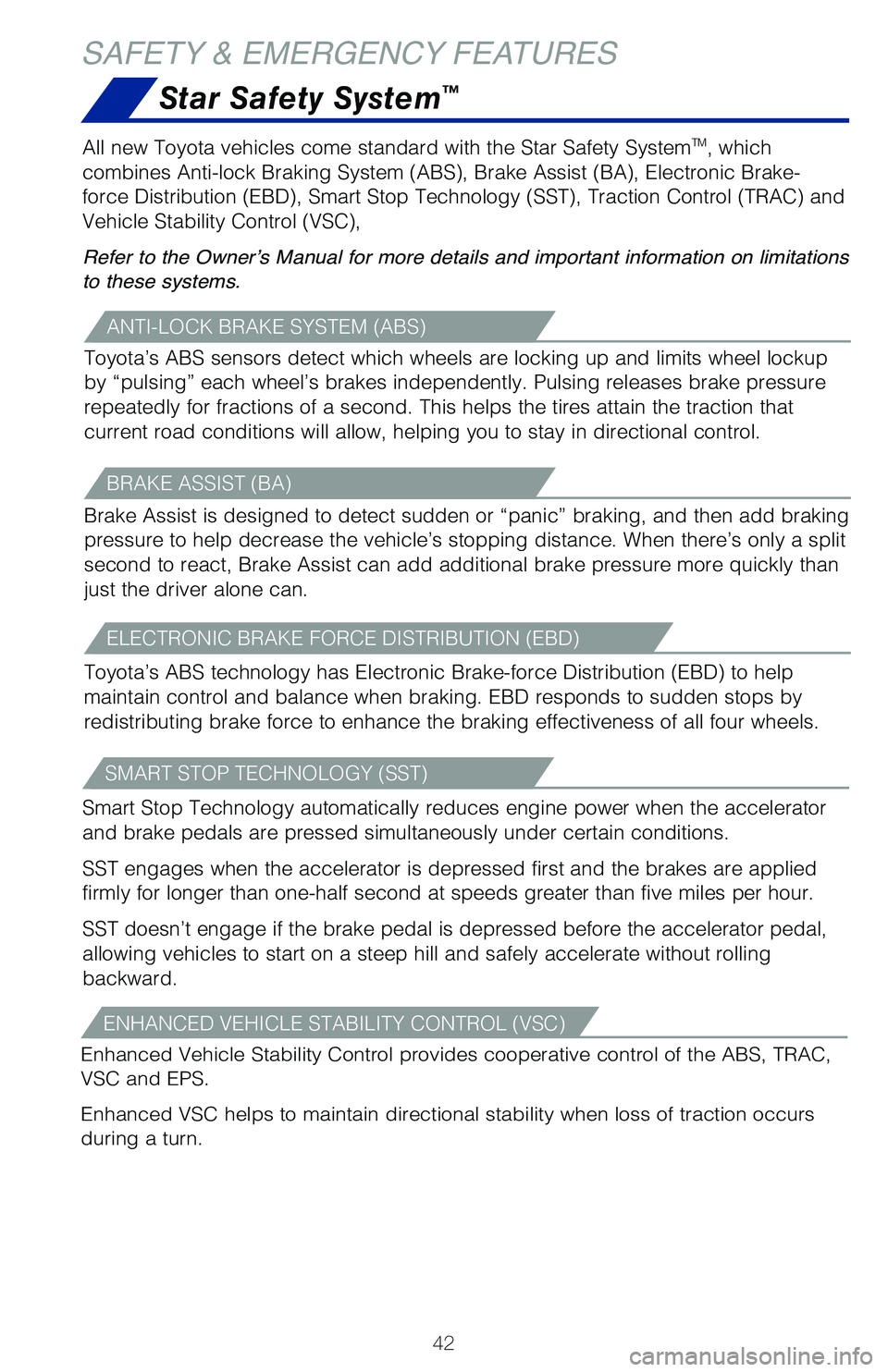engine TOYOTA CAMRY HYBRID 2020 (in English) User Guide
[x] Cancel search | Manufacturer: TOYOTA, Model Year: 2020, Model line: CAMRY HYBRID, Model: TOYOTA CAMRY HYBRID 2020Pages: 52, PDF Size: 2.89 MB
Page 32 of 52

30
TOYOTA SAFETY SENSE™
CHANGING PCS ALERT TIMING
FarMiddle
(default) Near
Monocular camera sensor
Millimeter
wave radar
As part of the Pre-Collision System, this function is also designed to f\
irst provide an
alert and then automatic braking if needed.
Refer to the Toyota Owner’s Manual for additional limitations and inf\
ormation.Under certain conditions, the PCS system included with the TSS-P package\
may
also help to detect a pedestrian in front of your vehicle using the in-v\
ehicle camera
and front grille-mounted radar. The in-vehicle camera of PCS detects a p\
otential
pedestrian based on size, profile, and motion of the detected pedestrian\
. However,
a pedestrian may not be detected depending on the conditions, including \
the
surrounding brightness and the motion, posture, size, and angle of the p\
otential
detected pedestrian, preventing the system from operating or engaging.
PCS PEDESTRIAN DETECTION
(1) Press “” switches and select or from the Multi-Information
Display (MID).
(2) Press “
” switches and select “Warning sensitivity” from the MID and th\
en
press “
”. The setting screen is displayed.
(3) Press “
” each time to change the setting. Each time it is pressed, the
response to the PCS alert timing changes as shown above. You can press “
” to
go back to the menu.
Note: PCS is enabled each time the engine switch is turned to Ignition On.
The system can be disabled/enabled and the alert timing of the system can be
changed. (Alert timing only, brake operation remains the same).
Page 39 of 52

37
SWITCHING TO CONSTANT SPEED CONTROL MODE
SETTING CONSTANT SPEED CONTROL
Note: When your vehicle is too close to a vehicle ahead, and sufficient automatic
deceleration via the cruise control is not possible, the display will flash and the
buzzer will sound to alert the driver. An example of this would be if another driver
cuts in front of you while you are following a vehicle. Depress the brake pedal to
ensure an appropriate vehicle-to-vehicle distance.
If you are already using DRCC “”, push button again to turn the system off
first, then push and hold button for at least 1.5 seconds to switch.
Note: When the engine is turned off, it will automatically default to DRCC.
(3) Acceleration when there are no longer any preceding vehicles driving
slower than the set speed The system accelerates until the set speed is reached. The system then
returns to constant speed cruising.
1.5 seconds
ADJUSTING DISTANCE (CONTINUED)
Refer to the Toyota Owner’s Manual for additional information on DRCC\
operation,
settings adjustments, limitations, and precautions before attempting to \
use it.To adjust speed or cancel, see steps (2) and (3) of ADJUSTING SET SPEED on
page 35.
Increase speed
Decrease speed
OVERVIEW
FEATURES & OPERATIONS
TOYOTA SAFETY SENSE
SAFETY & EMERGENCY FEATURES
Page 40 of 52

38
TOYOTA SAFETY SENSE™
AHB is a safety system designed to help drivers see more of what’s ah\
ead at
nighttime while reducing glare for oncoming drivers. When enabled, AHB u\
ses an
in-vehicle camera to help detect the headlights of oncoming vehicles and\
tail lights
of preceding vehicles, then automatically switches between high and low \
beams
as appropriate to provide the most light possible and enhance forward vi\
sibility.
By using high beams more frequently, the system may allow earlier detect\
ion of
pedestrians and obstacles.
Refer to the Toyota Owner’s Manual for additional information on AHB \
operation,
settings adjustments, limitations, and precautions before attempting to \
use it.
Automatic High Beams (AHB)
(1) With the engine switch in IGNITION ON mode, turn the headlight switch to “AUTO” or “
“ position.
(2) Push lever away from you.
(3) Press the “
” switch.
The AHB indicator will come on when the headlights are turned on automat\
ically
to indicate that the system is active.
Note: Pull the lever back toward you to turn the AHB system off.
The AHB indicator will turn off. Turn switch to “
” position and the manual high
beam indicator “
” turns on.
When all of these conditions are met, high beams will be automatically t\
urned on
(after approximately 1 second): • Vehicle speed is above approximately 21 mph (34 km/h.)
• The area ahead of the vehicle is dark.
• There are no oncoming or preceding vehicles with headlights or tail\
lights turned on.
• There are few street lights on the road ahead.
If any of these conditions occur, the system is designed to automaticall\
y turn off
high beams: • Vehicle speed drops below approximately 17 mph (27 km/h.)
• The area ahead of the vehicle is not dark.
• Oncoming or preceding vehicles have headlights or tail lights turne\
d on.
• There are many streetlights on the road ahead.
ACTIVATING THE AHB SYSTEM
CONDITIONS WHERE AHB WILL TURN ON/OFF AUTOMATICALLY
(1) (2)
Page 44 of 52

42
SAFETY & EMERGENCY FEATURESStar Safety System
™
ANTI-LOCK BRAKE SYSTEM (ABS)
Toyota’s ABS sensors detect which wheels are locking up and limits wh\
eel lockup
by “pulsing” each wheel’s brakes independently. Pulsing release\
s brake pressure
repeatedly for fractions of a second. This helps the tires attain the tr\
action that
current road conditions will allow, helping you to stay in directional c\
ontrol.
BRAKE ASSIST (BA)
Brake Assist is designed to detect sudden or “panic” braking, and \
then add braking
pressure to help decrease the vehicle’s stopping distance. When there\
’s only a split
second to react, Brake Assist can add additional brake pressure more qui\
ckly than
just the driver alone can.
ELECTRONIC BRAKE FORCE DISTRIBUTION (EBD)
Toyota’s ABS technology has Electronic Brake-force Distribution (EBD) to help
maintain control and balance when braking. EBD responds to sudden stops \
by
redistributing brake force to enhance the braking effectiveness of all f\
our wheels.
All new Toyota vehicles come standard with the Star Safety System
TM, which
combines Anti-lock Braking System (ABS), Brake Assist (BA), Electronic Brake-
force Distribution (EBD), Smart Stop Technology (SST), Traction Control (TRAC) and
Vehicle Stability Control (VSC),
Refer to the Owner’s Manual for more details and important information on limitations
to these systems.
SMART STOP TECHNOLOGY (SST)
Smart Stop Technology automatically reduces engine power when the accele\
rator
and brake pedals are pressed simultaneously under certain conditions.
SST engages when the accelerator is depressed first and the brakes are a\
pplied
firmly for longer than one-half second at speeds greater than five miles\
per hour.
SST doesn’t engage if the brake pedal is depressed before the acceler\
ator pedal,
allowing vehicles to start on a steep hill and safely accelerate without\
rolling
backward.
ENHANCED VEHICLE STABILITY CONTROL (VSC)
Enhanced Vehicle Stability Control provides cooperative control of the A\
BS, TRAC,
VSC and EPS.
Enhanced VSC helps to maintain directional stability when loss of tracti\
on occurs
during a turn.
Page 45 of 52

43
Floor mat installation
There are two types of Toyota floor mats: carpeted and all-weather. Each vehicle
has model-specific floor mats. Installation is easy.
To keep your floor mat properly positioned, follow these steps:
• Only use Toyota floor mats designed for your specific model.
• Use only one floor mat at a time, using the retaining hooks to keep\
the mat in place.
• Install floor mats right side up.
Always align the Δ marks
TRACTION CONTROL (TRAC)
VSC helps prevent loss of traction during cornering by reducing engine p\
ower, and
Traction Control helps maintain traction on loose gravel and wet, icy, o\
r uneven
surfaces by applying brake force to the spinning wheel(s).
Toyota’s TRAC sensors are activated when one of the drive wheels star\
ts to slip.
TRAC limits engine output and applies the brakes to the spinning wheel. \
This
transfers power to the wheels that still have traction to help keep you \
on track.